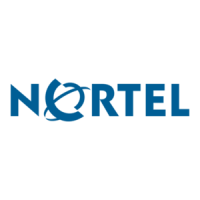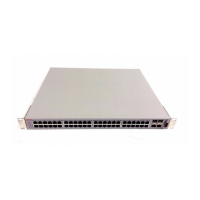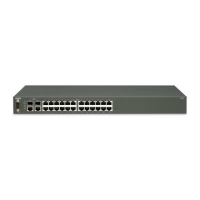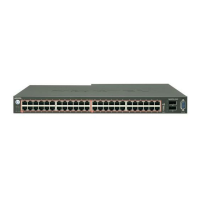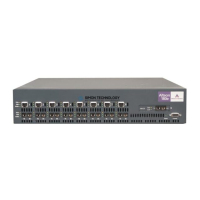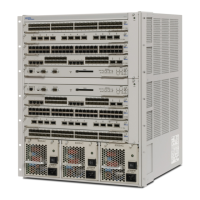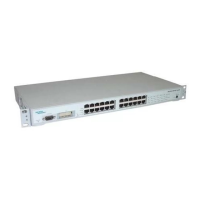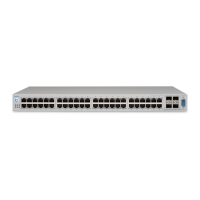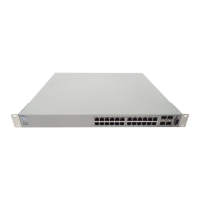Do you have a question about the Nortel 325-24T and is the answer not in the manual?
Outlines the expected background knowledge for network administrators using this guide.
Explains the typographical conventions used throughout the guide for clarity.
Lists other Nortel publications for additional information on switches and features.
Provides multiple avenues for obtaining technical support and assistance for Nortel products.
Details new functionalities introduced in software release 3.6 for the Ethernet Switches.
Explains the stacking capabilities of the Ethernet Switch 425-48T with other compatible units.
Describes the improved ability to set usernames and passwords for system access.
Explains the CLI command for safely shutting down and powering off the switch.
Details the CLI command used for configuration rollback and preventing connectivity loss.
Describes the CLI command to reset the switch or stack to its default configuration.
Provides details on the physical components of the Ethernet Switch 325.
Explains how to access the Console Interface (CI) for network customization.
Describes the RJ-45 port connectors used for network connectivity.
Details the physical components of the Ethernet Switch 425.
Explains the functionality of the UI button for stacking configuration tasks.
Details how to connect and manage units in a stack configuration for uninterrupted connectivity.
Describes the unique unit in a stack that can be configured via the front panel User Interface button.
Explains how a stack MAC address is automatically assigned during stack initialization.
Describes how configuration settings revert when a unit is removed from the stack.
Explains how cable connectors enable stacking up to eight switches.
Explains how to access CI menus and screens locally or remotely via console or Telnet.
Provides methods for navigating through the Console Interface menus and screens.
Details the CI screens and their fields, starting with the main menu.
Describes the options available from the Console Interface main menu.
Details the four command modes available in the Command Line Interface (CLI).
Explains the port numbering conventions for different Ethernet switch versions.
Describes how to access the Command Line Interface (CLI) via Telnet or direct connection.
Guides on setting usernames and passwords for system access through various interfaces.
Discusses basic navigation within the CLI, including shortcut commands and keystrokes.
Provides instructions for installing the Java Device Manager (JDM) software on various platforms.
Covers fundamental procedures for using the Device Manager software.
Details the steps for accessing the switch via its Web-based management interface.
Describes the structure and navigation of the Web-based management interface menu.
Explains how management pages are displayed upon selecting menu options.
Provides information on viewing summary data for switches and stacks.
Allows setting or modifying IP configuration parameters for the Ethernet Switch.
Enables setting or modifying SNMP configuration parameters for network management.
Allows viewing system characteristics like MAC address, uptime, and location.
Facilitates configuration and modification of console/comm port parameters and security.
Describes the process of logging into the switch via username and password prompts.
Allows renumbering of units configured within a stack for proper identification.
Enables updating the switch software image and diagnostics image via TFTP or HTTP.
Allows downloading an ASCII configuration file from a TFTP server via HTTP.
Explains how to synchronize the device's clock to Universal Coordinated Time (UTC).
Details how to configure IP, subnet mask, and default gateway settings via CLI.
Sets the IP default gateway address for a switch or stack.
Displays IP configurations including BootP mode, stack, switch, subnet mask, and gateway.
Explains how to test network connectivity to a device using the ping command.
Describes the command to reset the switch or stack to its default factory configuration.
Explains how to use the DNS client to ping or telnet to a host by IP address or name.
Covers downloading and managing configuration and image files.
Provides a tool to easily modify the configuration of a switch or stack.
Displays the current configuration of a switch or stack as a series of CLI commands.
Copies the current configuration file to another file on the TFTP server.
Explains how to customize system settings using CLI commands.
Shows how to view basic system information like software version and stack mode.
Covers rebooting the switch/stack and configuring BootP settings.
Configures BootP on the current instance of the switch or server.
Covers displaying, assigning, copying, and retrieving TFTP server configuration files.
Explains how to enable or disable a port using the CLI commands.
Describes how to name a port or change its name using the CLI.
Details how to set the speed and duplex mode for a port.
Explains how to control traffic on Gigabit Ethernet ports using the flowcontrol command.
Allows limiting broadcast or multicast traffic percentages on a port via CLI.
Enables control over capabilities advertised during auto-negotiation.
Explains how to view unit information using the Device Manager's Unit dialog box.
Describes how to view switch IP information using the Device Manager's IP dialog box.
Provides instructions for editing chassis configuration via the Edit Chassis dialog box.
Details how to view, upload, or download configuration and image files.
Explains how to configure Simple Network Time Protocol (SNTP) settings.
Describes diagnostic information available in Device Manager's Topology tabs.
Guides on viewing and editing the configuration and status of a single port.
Shows the basic configuration and status of a single port within Device Manager.
Provides steps for viewing and editing configurations for multiple ports simultaneously.
Displays basic configuration and status for multiple selected ports.
Allows viewing system information, stack configuration, and contact details.
Facilitates initial setup by consolidating multiple setup pages into a single screen.
Explains how to reboot a switch or stack without erasing configured parameters.
Guides on resetting a switch or stack to factory default values.
Details the procedure for logging out of the Web-based management user interface.
Allows configuration of BootP modes, IP addresses, subnet masks, and default gateway.
Enables creation or modification of system name, location, and network manager contact info.
Allows configuring port autonegotiation for speed and duplex settings.
Provides parameters for configuring high speed flow control for Gigabit Ethernet.
Explains how to download software images to non-volatile flash memory.
Details uploading ASCII configuration files using HTTP protocol, eliminating TFTP requirement.
Describes storing and retrieving configuration parameters to/from a TFTP server.
Allows enabling or disabling the autosave feature for configuration files.
Covers viewing console/communication port settings and configuring console port speed.
Allows configuring threshold limits for broadcast or multicast packets on a port.
Provides guidance on understanding the meaning of various LEDs on the switch.
Outlines steps to isolate and diagnose issues with the Ethernet Switch.
Addresses issues related to cable connections or improper port cable connections.
Explains potential mode mismatches during autonegotiation between devices.
Lists important guidelines and precautions before installing an SFP transceiver.
Describes SFPs, their labels, and provides model lists for SX, LX, and CWDM SFPs.
Provides step-by-step instructions for installing SFP transceivers into the module.
Details the technical specifications for various SFP models.
Describes the RJ-45 port connectors and their wiring for end station connections.
Explains the Media Dependent Interface (MDI) standards and crossover functions.
Illustrates direct connections from MDI-X ports to end stations without crossover cables.
Details the DB-9 connector configuration for management station connections.
Lists the factory default settings for the Ethernet Switch according to CI screens.
Provides a sample BootP configuration file for software download and configuration.
An alphabetical list of all CLI commands with approximate page references for explanations.
Lists the operating and storage environmental specifications for the switch.
Provides power electrical parameters for the Ethernet Switch.
Details the physical dimensions for the Ethernet Switch 325 and 425.
Lists the performance specifications for the Ethernet Switch 325 and 425.
Lists the protocols and standards used by the Ethernet Switch 425-24T.
Details the electromagnetic emission standards for the Ethernet Switch 425-24T.
Outlines the expected background knowledge for network administrators using this guide.
Explains the typographical conventions used throughout the guide for clarity.
Lists other Nortel publications for additional information on switches and features.
Provides multiple avenues for obtaining technical support and assistance for Nortel products.
Details new functionalities introduced in software release 3.6 for the Ethernet Switches.
Explains the stacking capabilities of the Ethernet Switch 425-48T with other compatible units.
Describes the improved ability to set usernames and passwords for system access.
Explains the CLI command for safely shutting down and powering off the switch.
Details the CLI command used for configuration rollback and preventing connectivity loss.
Describes the CLI command to reset the switch or stack to its default configuration.
Provides details on the physical components of the Ethernet Switch 325.
Explains how to access the Console Interface (CI) for network customization.
Describes the RJ-45 port connectors used for network connectivity.
Details the physical components of the Ethernet Switch 425.
Explains the functionality of the UI button for stacking configuration tasks.
Details how to connect and manage units in a stack configuration for uninterrupted connectivity.
Describes the unique unit in a stack that can be configured via the front panel User Interface button.
Explains how a stack MAC address is automatically assigned during stack initialization.
Describes how configuration settings revert when a unit is removed from the stack.
Explains how cable connectors enable stacking up to eight switches.
Explains how to access CI menus and screens locally or remotely via console or Telnet.
Provides methods for navigating through the Console Interface menus and screens.
Details the CI screens and their fields, starting with the main menu.
Describes the options available from the Console Interface main menu.
Details the four command modes available in the Command Line Interface (CLI).
Explains the port numbering conventions for different Ethernet switch versions.
Describes how to access the Command Line Interface (CLI) via Telnet or direct connection.
Guides on setting usernames and passwords for system access through various interfaces.
Discusses basic navigation within the CLI, including shortcut commands and keystrokes.
Provides instructions for installing the Java Device Manager (JDM) software on various platforms.
Covers fundamental procedures for using the Device Manager software.
Details the steps for accessing the switch via its Web-based management interface.
Describes the structure and navigation of the Web-based management interface menu.
Explains how management pages are displayed upon selecting menu options.
Provides information on viewing summary data for switches and stacks.
Allows setting or modifying IP configuration parameters for the Ethernet Switch.
Enables setting or modifying SNMP configuration parameters for network management.
Allows viewing system characteristics like MAC address, uptime, and location.
Facilitates configuration and modification of console/comm port parameters and security.
Describes the process of logging into the switch via username and password prompts.
Allows renumbering of units configured within a stack for proper identification.
Enables updating the switch software image and diagnostics image via TFTP or HTTP.
Allows downloading an ASCII configuration file from a TFTP server via HTTP.
Explains how to synchronize the device's clock to Universal Coordinated Time (UTC).
Details how to configure IP, subnet mask, and default gateway settings via CLI.
Sets the IP default gateway address for a switch or stack.
Displays IP configurations including BootP mode, stack, switch, subnet mask, and gateway.
Explains how to test network connectivity to a device using the ping command.
Describes the command to reset the switch or stack to its default factory configuration.
Explains how to use the DNS client to ping or telnet to a host by IP address or name.
Covers downloading and managing configuration and image files.
Provides a tool to easily modify the configuration of a switch or stack.
Displays the current configuration of a switch or stack as a series of CLI commands.
Copies the current configuration file to another file on the TFTP server.
Explains how to customize system settings using CLI commands.
Shows how to view basic system information like software version and stack mode.
Covers rebooting the switch/stack and configuring BootP settings.
Configures BootP on the current instance of the switch or server.
Covers displaying, assigning, copying, and retrieving TFTP server configuration files.
Explains how to enable or disable a port using the CLI commands.
Describes how to name a port or change its name using the CLI.
Details how to set the speed and duplex mode for a port.
Explains how to control traffic on Gigabit Ethernet ports using the flowcontrol command.
Allows limiting broadcast or multicast traffic percentages on a port via CLI.
Enables control over capabilities advertised during auto-negotiation.
Explains how to view unit information using the Device Manager's Unit dialog box.
Describes how to view switch IP information using the Device Manager's IP dialog box.
Provides instructions for editing chassis configuration via the Edit Chassis dialog box.
Details how to view, upload, or download configuration and image files.
Explains how to configure Simple Network Time Protocol (SNTP) settings.
Describes diagnostic information available in Device Manager's Topology tabs.
Guides on viewing and editing the configuration and status of a single port.
Shows the basic configuration and status of a single port within Device Manager.
Provides steps for viewing and editing configurations for multiple ports simultaneously.
Displays basic configuration and status for multiple selected ports.
Allows viewing system information, stack configuration, and contact details.
Facilitates initial setup by consolidating multiple setup pages into a single screen.
Explains how to reboot a switch or stack without erasing configured parameters.
Guides on resetting a switch or stack to factory default values.
Details the procedure for logging out of the Web-based management user interface.
Allows configuration of BootP modes, IP addresses, subnet masks, and default gateway.
Enables creation or modification of system name, location, and network manager contact info.
Allows configuring port autonegotiation for speed and duplex settings.
Provides parameters for configuring high speed flow control for Gigabit Ethernet.
Explains how to download software images to non-volatile flash memory.
Details uploading ASCII configuration files using HTTP protocol, eliminating TFTP requirement.
Describes storing and retrieving configuration parameters to/from a TFTP server.
Allows enabling or disabling the autosave feature for configuration files.
Covers viewing console/communication port settings and configuring console port speed.
Allows configuring threshold limits for broadcast or multicast packets on a port.
Provides guidance on understanding the meaning of various LEDs on the switch.
Outlines steps to isolate and diagnose issues with the Ethernet Switch.
Addresses issues related to cable connections or improper port cable connections.
Explains potential mode mismatches during autonegotiation between devices.
Lists important guidelines and precautions before installing an SFP transceiver.
Describes SFPs, their labels, and provides model lists for SX, LX, and CWDM SFPs.
Provides step-by-step instructions for installing SFP transceivers into the module.
Details the technical specifications for various SFP models.
Describes the RJ-45 port connectors and their wiring for end station connections.
Explains the Media Dependent Interface (MDI) standards and crossover functions.
Illustrates direct connections from MDI-X ports to end stations without crossover cables.
Details the DB-9 connector configuration for management station connections.
Lists the factory default settings for the Ethernet Switch according to CI screens.
Provides a sample BootP configuration file for software download and configuration.
An alphabetical list of all CLI commands with approximate page references for explanations.
Lists the operating and storage environmental specifications for the switch.
Provides power electrical parameters for the Ethernet Switch.
Details the physical dimensions for the Ethernet Switch 325 and 425.
Lists the performance specifications for the Ethernet Switch 325 and 425.
Lists the protocols and standards used by the Ethernet Switch 425-24T.
Details the electromagnetic emission standards for the Ethernet Switch 425-24T.
